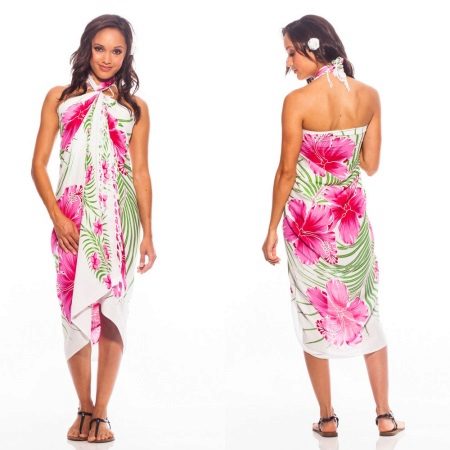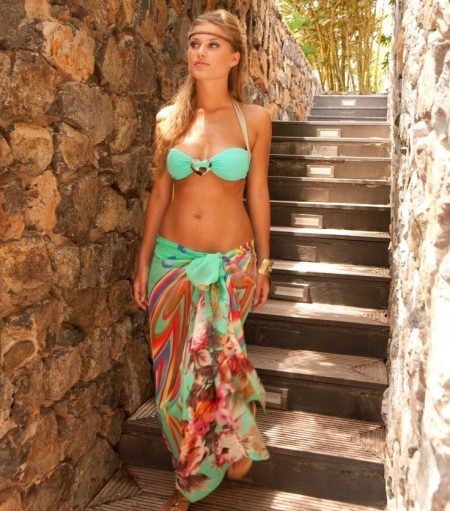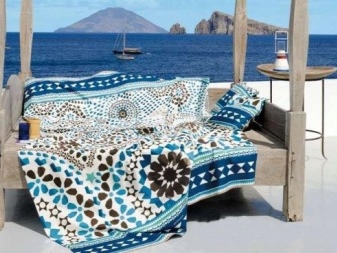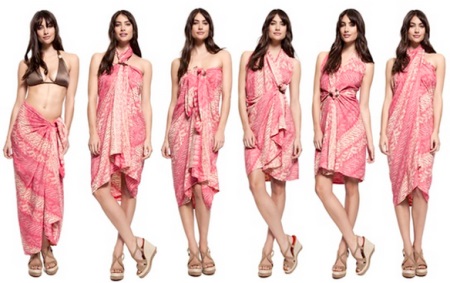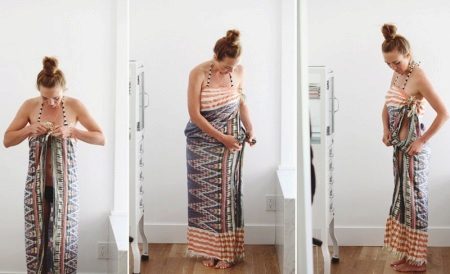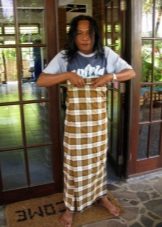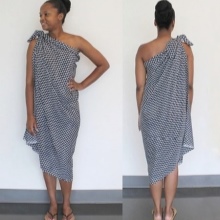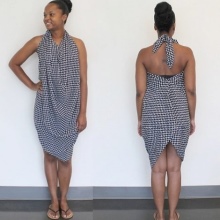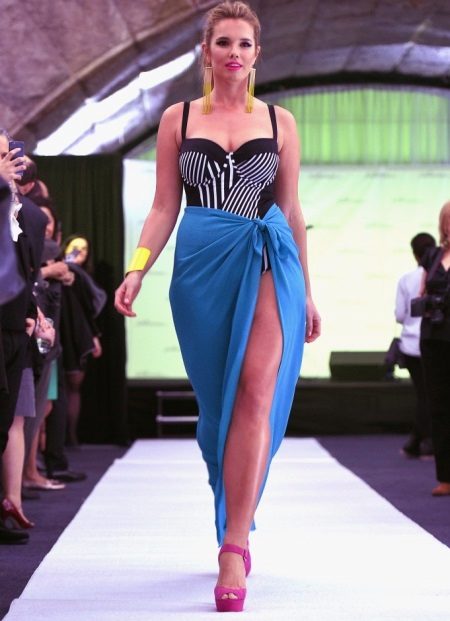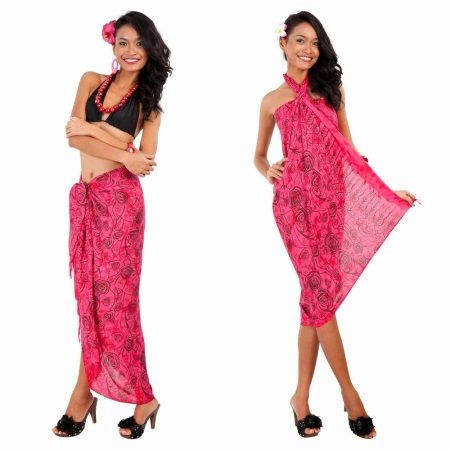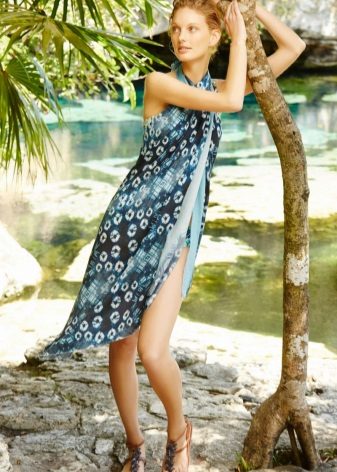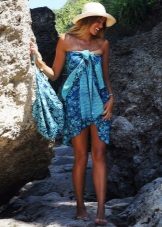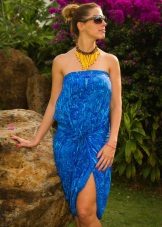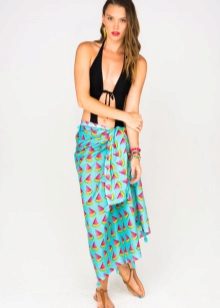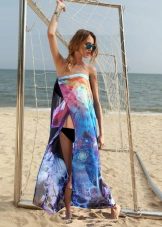In beach fashion, there are many options for clothing from all over the world. If the pareo has become a familiar part of the summer wardrobe, then they are still looking at the sarong.
At home, it can be called differently, including "Mundu".
Sarong is a square or rectangular scarf with a rather long side - about 2 m.
It is precisely in its length that the sarong differs from the pareo, which has already become part of our life. The longest side of the pareo is usually 1.4 m.
There are many ways to tie a sarong, so one such shawl can replace several things. For tourists, multifunctionality is very important, so we advise you to pay attention to it!
Features
For the indigenous population, a sarong is a complete garment, the middle between a skirt and a dress. In different nations it is only the female or only the masculine part of the wardrobe, the others have it all. Depending on the stability of national traditions, the sarong turned into a festive and religious costume, which is customarily worn on exceptional occasions, or became a distinctive element of the Aboriginal people, representing an integral part of everyday clothing.
Native people use handkerchiefs from practical natural fabrics of traditional colors, and tourists choose light, obedient and flying sarongs made of cotton, silk, chiffon, satin. Special rings and buckles fix the sarong, which is very comfortable to wear. Thais often fix the fabric on the body, imitating the trousers.
The special grace that clothing gives women, smooth movements and the ability to easily change their shape made the sarong object of interest of designers. Thus, the summer wardrobe has been replenished with a universal and beautiful detail, giving the image a mystery. Unusual colors, their combinations and fancy patterns were also invented to suit shawls.
In addition to traditional methods of dyeing and weaving threads, they began to use painting on fabric (for example, batik or ikat).
Having brought a sarong home, it can be made an art object (bag, headscarf or neck scarf) or even an interior item (in the form of a curtain, bedspread, panel, tablecloth). And you can put in a suitcase, waiting for new travels.
How to tie?
Sarong has a large size, so if you have imagination you can create romantic or ethnic images. Most often, a sarong is tied to the hips or waist, like a skirt.
Consider common ways of tying sarong. Many of them are simple and will not take much time.
Caribbean version
Allows you to select the height of the scarf on the body: on the hips or high under the breast. Turning a handkerchief, you need to tie the tails in front of the knot (you can leave them both free and hide). A more elegant way is different in that the knot is made shifted: one end is taken, and as the second tail for the knot, they simply intercept a piece of cloth along the top. The rest of the matter is arranged as a smell, gently tucking it around the waist and masking the knot.
Thai version
They arrange the fabric vertically, wrap the short edge around the body and tie it in front. The bottom of the shawl is twisted on one or two sides, the ends are lifted to the waist and the first knot is hidden by this drapery. You can hold the fabric below the legs, so harem pants. This option is reliable and easy to use.
In burma
Stitch the sarong along the short edge, leaving through holes.Wearing a "pipe", intercepting the "tails" along the upper edge, tying them in front, folds looking inward are obtained. Knot-tails wrapped inside. This method will help turn the scarf into a skirt or dress.
The simplest options are to fold the fabric along, wrap the fabric around the hips and tie the upper edges. So the miniskirt will be ready. Beautiful asymmetrical skirts are obtained by adding a square sarong.
Master classes will help make the dress in seconds:
- Having missed the fabric behind your back, cross the upper ends on your chest, roll them into strands and tie them back on your neck.
- Leave one edge on the side, lifting the sarong over the chest, hold the scarf behind your back and wrap it around the body, you will have an overlap of fabric on your back. Try to leave the lower corner of the shawl above the fabric free. The second upper corner may also be on the side. These ends will serve as straps: lift them forward upward from under the armpits, tie them up at the back of the neck.
- Similarly, a shorter handkerchief can be tied on one shoulder: the middle of the sarong is oriented to one side, on the other hand, the armpits overlap the fabric, the corners of the scarf are folded into braids after this cross, raised to the shoulder and tied on top. It turns out an asymmetrical dress in antique style.
These are the most popular ways. It is worth experimenting to find your own version, because a well-chosen pattern and a properly tied sarong will add elegance to the figure.
For example, ladies with a magnificent bust better to tie a sarong like a skirt, and with a miniature - to make knots on the chest. Correct completeness will help the correct vertical or diagonal pattern. Add a growth handkerchief tied above the waist. The narrower the shoulders, the higher the sarong should be.
What to wear?
Indigenous people wear these skirts with special blouses. But the rest of the world prefers to use the sarong as part of a beach outfit, combining with separate and monolithic swimsuits, tops and light open shoes.
Elegant and exclusive scarves can be worn at summer parties as a dress, complementing the outfit with sandals on the heel or platform. Plain flip flops and beach flip flops complete any look with sarong. There will be interesting variations with shoes on ties, when ribbons, straps “embrace” the legs.
Accessories
Given the specifics of such summer clothes, from accessories you can stay in hats, headbands and scarves. Bright jewels will find their place. It can be inexpensive jewelry, colorful earrings, bracelets, massive necklaces of stones or glass. Interesting sets of shells, coral, feathers.
Beach images like bags made from natural materials: cotton, straw, etc. Large or small, hard or soft as kotomotochki, the most diverse forms - it depends on your preferences and necessity.
Special buckles-buttons help to secure the outfit securely, as for scarves. They come in different shapes, which allows you to make the image even more sophisticated and elegant. Putting on a sarong as a dress, you can gird it. Modern interpretation allows it.
The summer image does not do without large sunglasses, because such glasses will help protect your eyes from the scorching rays. Sarong, as an outfit, is not only a tribute to fashion and beauty, but also a very functional comfortable thing that can become the main element of the image. It is worth getting a pair of sarong scarves to change your look every day!

